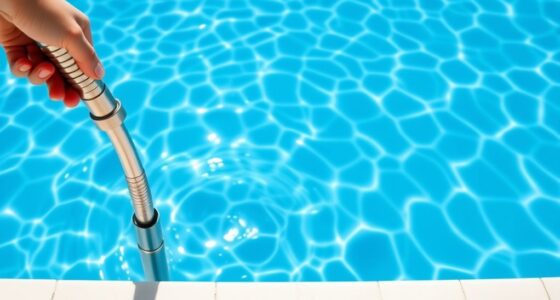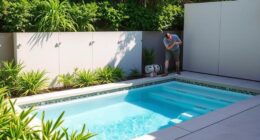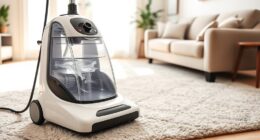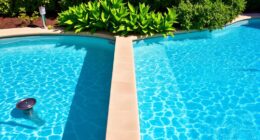To effectively manage algae on spill walls, start by evaluating the extent of growth and damage, then choose appropriate cleaning methods like chemical or eco-friendly solutions based on severity. Apply protective coatings, such as algae-resistant paints, and establish regular inspection and maintenance routines. Train staff on proper procedures and safety protocols to keep the area clean and safe. Continuing with this plan helps ensure long-term protection and understanding of best practices for spill wall care.
Key Takeaways
- Conduct regular assessments to identify algae buildup, surface damage, and determine appropriate cleaning methods.
- Use targeted chemical, mechanical, or eco-friendly cleaning techniques based on algae severity and surface material.
- Apply protective, algae-resistant coatings and treatments to prevent future growth and extend wall lifespan.
- Train staff on proper cleaning procedures, safety protocols, and documentation for consistent maintenance.
- Maintain detailed records of inspections and cleanings to monitor algae trends and optimize long-term management.
Assessing the Extent of Algae Growth and Damage

Before you begin treatment, it’s essential to assess how much algae has grown and what damage it has caused. Examine the spill wall carefully, looking for visible signs of algae buildup, discoloration, or slimy patches. Check for areas where algae may have penetrated or caused deterioration, such as cracks, peeling paint, or corrosion. Take note of the extent and density of the algae—whether it’s localized or widespread. Document these observations with photos and detailed notes. Understanding the severity helps you determine the appropriate cleaning methods and safety precautions. Accurate assessment guarantees you don’t underestimate the contamination, preventing future issues. This step is critical for developing an effective, targeted removal plan that restores the spill wall’s integrity and appearance.
Selecting Appropriate Cleaning and Removal Techniques

Choosing the right cleaning method depends on the severity of algae growth and the surface material. You can opt for chemical cleaners, mechanical removal, or eco-friendly solutions based on your specific situation. Consider the effectiveness and environmental impact of each option to guarantee safe and thorough removal. Additionally, using appropriate spray tips can help ensure an even application of cleaning agents and improve overall cleaning efficiency.
Chemical Cleaning Options
When selecting chemical cleaning options for algae removal on spill walls, it’s crucial to take into account the type and extent of the algae growth, as well as the surface material. Different algae species respond best to specific chemicals, so identify the algae type before choosing a cleaner. For light growth, diluted bleach solutions or commercial biocides may suffice. Heavier infestations might require stronger chemicals like quaternary ammonium compounds or specialized algaecides. Always consider the surface material—concrete, metal, or painted surfaces—since some chemicals can cause damage or discoloration. Test a small area first to observe reactions. Follow manufacturer instructions carefully, wear appropriate protective gear, and guarantee proper ventilation. Proper chemical selection ensures effective algae removal while minimizing surface damage. Additionally, understanding the algae growth patterns can help in selecting the most effective treatment approach.
Mechanical Removal Methods
Selecting the appropriate mechanical removal techniques depends on the type of algae, the surface material, and the severity of growth. For light algae buildup, use soft brushes or scrapers to gently remove the algae without damaging the surface. If algae is more established, power washers with low pressure can be effective; however, avoid high-pressure streams that could erode or crack the material. For concrete or rough surfaces, you may need handheld tools like scrapers or wire brushes to loosen stubborn growth. Always work from the top down to prevent splashing contaminated water onto clean areas. After removal, rinse the surface thoroughly with water to wash away loosened algae and debris. Properly selecting and applying these mechanical methods ensures effective cleaning while minimizing surface damage. Additionally, understanding the resources and tools available can help in choosing the most suitable method for your specific situation.
Eco-Friendly Solutions
Eco-friendly solutions offer effective ways to control algae growth on spill walls without harming the environment. You can choose natural cleaners like vinegar, baking soda, or eco-friendly commercial products designed for algae removal. These options break down algae while being safe for plants, animals, and water sources. When applying, use a soft brush or low-pressure spray to scrub algae off surfaces gently. Avoid harsh chemicals that can damage the environment or your spill wall material. Regularly inspecting and cleaning with eco-friendly solutions helps prevent algae buildup before it becomes a problem. These methods are sustainable, cost-effective, and safe for ongoing maintenance. By prioritizing eco-friendly techniques, you protect your site and contribute to a healthier ecosystem. Additionally, understanding the role of attention in effective cleaning routines can enhance your results and ensure thorough algae removal.
Implementing Preventative Coatings and Treatments

Implementing preventative coatings and treatments is a crucial step in controlling algae growth on spill walls. These coatings create a physical barrier that inhibits algae from attaching and thriving on surfaces. Choose high-quality, algae-resistant paints or sealants specifically designed for outdoor or industrial environments. Apply the coatings evenly, following manufacturer instructions, and verify surfaces are clean and dry beforehand. Regular treatments with algaecides can further prevent growth, especially during warm, humid months. Using these treatments proactively reduces the need for frequent cleanings and minimizes algae buildup over time. Remember, the goal is to make the spill wall less hospitable for algae, so combining durable coatings with preventive treatments offers the best long-term protection. This approach saves maintenance time and preserves the integrity of your spill wall.
Establishing Regular Inspection and Maintenance Schedules

To effectively manage algae growth on spill walls, you need to establish a routine of regular inspection and maintenance. Set a schedule to check your spill walls weekly or biweekly, depending on environmental conditions. During inspections, look for signs of algae buildup, discoloration, or surface damage. Promptly address any issues by cleaning affected areas with appropriate solutions and reapplying protective coatings if needed. Keep detailed records of inspections, cleaning dates, and repairs to track patterns and identify recurring problems. Regular maintenance prevents algae from establishing a foothold and reduces long-term cleanup efforts. Environmental factors such as moisture and sunlight significantly influence algae proliferation. Consistency is key; sticking to your schedule guarantees algae growth stays under control and your spill walls remain functional and visually clean.
Training Staff on Proper Spill Wall Care Procedures

Training your staff on spill wall care guarantees everyone understands their responsibilities and communicates effectively. You need to teach regular maintenance techniques and emphasize safety and handling procedures to prevent algae buildup. Clear protocols help keep spill walls in prime condition and protect your team from potential hazards.
Clear Communication Protocols
Effective communication is essential to guarantee staff understand their roles in maintaining spill wall integrity. You should establish clear protocols for reporting issues, such as algae buildup or damage, ensuring everyone knows who to contact and how to document concerns. Use straightforward language and standardized forms or checklists to reduce confusion. Hold regular team meetings to reinforce procedures and address questions. Make sure instructions are accessible and easy to follow, whether through printed guides or digital resources. Encourage open dialogue so staff feel comfortable reporting problems promptly. Consistent communication minimizes misunderstandings and ensures timely responses, helping to prevent algae growth from worsening. Additionally, understanding narcissistic manipulation tactics can help staff recognize and address any underlying issues more effectively. By fostering a culture of clear, direct interaction, you enhance the effectiveness of your spill wall maintenance efforts.
Regular Maintenance Techniques
Proper spill wall care begins with ensuring your staff understand and consistently apply correct maintenance techniques. Training them on these methods helps prevent algae buildup and prolongs the wall’s effectiveness. Emphasize routine inspections, cleaning schedules, and proper cleaning tools. Clear procedures ensure everyone knows their responsibilities and maintains consistency. Use the table below to highlight key maintenance practices and their importance:
| Maintenance Practice | Why It Matters |
|---|---|
| Regular Inspections | Detect issues early and prevent algae growth |
| Scheduled Cleaning | Keeps surfaces free of algae and debris |
| Proper Cleaning Tools | Ensures effective algae removal |
| Documentation of Tasks | Tracks maintenance history and accountability |
Additionally, understanding the importance of consistency in maintenance routines can significantly reduce algae accumulation and maintain spill wall integrity over time.
Safety and Handling Procedures
Maintaining a spill wall safely requires clear procedures and well-trained staff to safeguard against risks and guarantee proper handling. You must understand the correct safety protocols before performing any maintenance or cleaning. Always wear personal protective equipment, like gloves and eye protection, to prevent exposure to algae or cleaning chemicals. Follow the manufacturer’s instructions for cleaning agents and disposal methods. When handling spill wall cleaning tools, ensure they are used correctly to avoid damage or injury. Regularly review safety procedures with your team, emphasizing hazard recognition and emergency response. Proper training minimizes accidents and ensures spill walls are maintained effectively. Additionally, understanding the flat iron bike can provide insights into efficient maintenance techniques for high-performance equipment. By prioritizing safety and proper handling, you protect yourself, your team, and the environment while guaranteeing the spill wall remains in excellent condition.
Documenting Maintenance Activities and Monitoring Effectiveness

To guarantee spill wall algae management remains effective over time, you need to systematically document maintenance activities and monitor their results. Keep detailed records of each cleaning, treatment, and inspection, noting dates, methods used, and any issues encountered. This documentation helps identify patterns, track progress, and determine when treatments need adjustments. Regular monitoring involves visual inspections and, if necessary, testing for algae regrowth or residual contamination. By comparing observations over time, you can assess the effectiveness of your strategies and make informed decisions for future maintenance. Consistent documentation and monitoring ensure you catch problems early, maintain spill wall integrity, and optimize your algae control efforts. Staying organized and vigilant is key to long-term success. Incorporating dog names as part of your team can also boost morale and ensure tasks are completed with enthusiasm.
Frequently Asked Questions
How Often Should Spill Walls Be Inspected for Algae Growth?
You should inspect spill walls for algae growth at least once a month. Regular inspections help you catch algae early before it spreads or causes damage. After heavy rain or high humidity, consider checking more frequently, as these conditions promote algae growth. Keep an eye out for discoloration, slimy textures, or unusual odors. Promptly addressing algae guarantees your spill walls stay clean, functional, and compliant with safety standards.
What Environmental Factors Influence Algae Proliferation on Spill Walls?
You know what they say, “Prevention is better than cure.” Environmental factors like sunlight, moisture, and temperature directly influence algae growth on spill walls. You should monitor these conditions regularly, as increased sunlight and humidity create ideal environments for algae to thrive. Keep an eye on temperature fluctuations too, since warm, humid conditions accelerate proliferation. Managing these factors helps you stay ahead of algae and maintain spill wall integrity efficiently.
Are There Eco-Friendly Cleaning Options for Algae Removal?
Yes, you can use eco-friendly cleaning options for algae removal. Vinegar mixed with water effectively kills algae without harmful chemicals. You might also consider using baking soda or biodegradable algae cleaners that are safe for the environment. Regularly scrubbing the surface and rinsing thoroughly helps prevent algae buildup. These methods are safe, sustainable, and effective, ensuring you protect the environment while maintaining spill wall cleanliness.
How Can I Identify Early Signs of Spill Wall Deterioration?
You might think spotting deterioration is tough, but early signs are clear. Look for cracks, peeling paint, or discoloration—these indicate weakening. Pay attention to any water leaks or unusual moisture around the wall, as these can signal underlying damage. Regular inspections, especially after storms or temperature changes, help you catch issues early. Addressing these signs promptly prevents costly repairs and keeps your spill wall in top condition.
What Are the Costs Associated With Various Algae Management Strategies?
You’ll find costs vary depending on your chosen strategy. Chemical treatments like algaecides can be affordable initially but may require repeated applications, increasing expenses over time. Mechanical removal involves labor and equipment costs but offers a more permanent solution. Biological methods, such as introducing algae-eating organisms, can be cost-effective long-term but may have higher setup costs. Consider your budget, environmental impact, and effectiveness to select the best approach.
Conclusion
By following these steps, you’ll keep your spill walls algae-free and well-maintained, much like the diligent caretakers of ancient aqueducts. Regular inspections and proper treatments guarantee your walls stay resilient, saving you from costly repairs and unsightly damage. Remember, a proactive approach today prevents a algae-infested mess tomorrow. Don’t let your spill walls become the stuff of legend—stay vigilant and keep them pristine, just like the great engineers of old.









